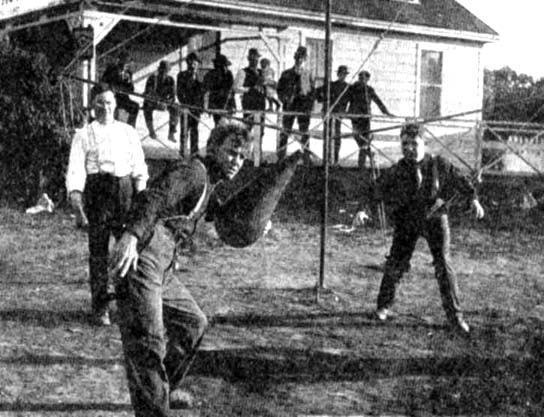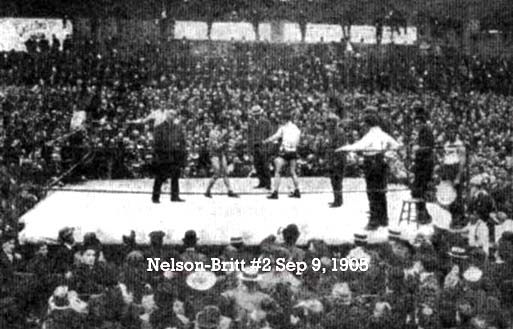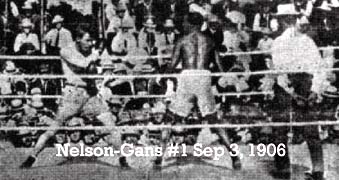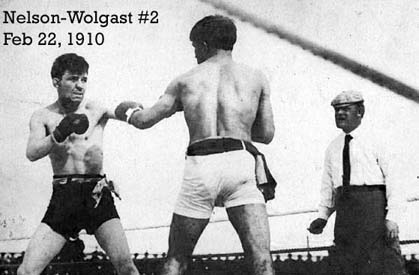February 2006
Rinsing Off the Mouthpiece
By GorDoom
Poem of the Month
By Tom Smario
The 2005 CBZ Year-End Awards
By J.D. Vena
Women to Watch For in 2006
By Adam
Pollack
INTERVIEWS:
Lou DiBella: No Joe Palooka
By Dave Iamaele
Lamon Brewster, Unplugged
By Juan C.
Ayllon
Touching Gloves with...
Clyde Gray
By Dan
Hanley
PROFILES:
Iron Mike Tyson: Myth or Monster?
By
Jim Trunzo
Jess Sandoval: The Coach Says,
"Bundle Up"
By
Katherine Dunn
The Legend of the Cuban Baron,
Ramon Castillo
By Enrique Encinsoa
Paul Thorn
By Pete Ehrman
Battling Nelson: Always Battered,
Seldom Beaten
By Tracy Callis
Kid Chocolate,
the Cuban Bon Bon
By Monte Cox
BOOK REVIEWS AND EXCERPTS:
Shadow Boxers
Photographs by Jim
Lommasson
The Iceman Diaries
by John Scully
The Boxing Bookshelf
by Dave Iamele
|

Battling Nelson:
Always Battered,
Seldom Beaten
By Tracy Callis
Oscar "Battling" Nelson was one of the roughest, toughest men to ever enter
the ring, no doubt about it. He could box a little but rarely did. He preferred to brawl.
His defense consisted of a thick dome that absorbed punches like a sponge absorbs water.
He got in there to do what he loved best -- fight -- to batter and get battered. He
detested the rules of the ring.
Some men are blessed with speed and quickness, others have power. Nelson had an abundance
of grit, stamina, and the will to win. McCallum (1975, p.231) described him as "a slightly
built, scrawny-looking, little man, with sunken cheeks, haunted, deep-set eyes, and a
slender, almost fragile body, a consumptive pallor, and hands too big for the rest of
him."
"They called him the 'Durable Dane,'" according to Golesworthy (1960, p.154), "and this
fighter, who was born in Copenhagen in 1882, certainly was one of the toughest men ever
seen in the ring."
"Some people say I'm not human," proclaimed Nelson (see Nelson 1908 p 73), and writer
Robert Howard echoed that, describing Nelson as "not human when it comes to taking
punishment" (1976, p.46).
Absolutely one of the most determined men to ever lace on a glove, Nelson used any means
to win. If his blows failed to do the trick, he used his vicious "scissors hook." This was
a short left hook aimed at the liver or kidneys with his thumb and forefinger extended to
give a painful pinch or stab.
NELSON GAVE NEW MEANING TO THE WORD "TOUGH"
Nelson specialized in taking it to the head (or otherwise) and punching to the body.
Gilbert Odd, the great boxing historian, asserted that Nelson earned a reputation for the
sort of body punching that could make a strong man urinate blood for a week. Nelson's left
hook was usually targeted on either the liver or the kidney and was followed by his thumb.
Said Odd, "The thin gloves of his day enabled him to pinch his unfortunate opponent the
moment his left hook landed" (see Suster, 1994, p.30).
"Few tougher men ever entered the ring" reported Suster (1994, pp.5, 26), and he added,
"He was a ruthless, dirty fighter who gave no quarter and asked none, often gouging eyes
and shifting his knee into an opponent's groin as he broke his nose with an elbow."
McCallum remarked, "Nelson would have been right at home among the bare-knuckle boys of
the gaslight era" (1975, p.232).
Bat was not a particularly difficult man to knock down. He visited the canvas rather
often. But it was well nigh impossible to keep him down. He fought coming straight toward
his man, throwing punches and taking them in. Every so often, he got nailed -- hard -- and
sometimes he went down. But up he came. Early in his career, Joe Hedmark put him down 17
times, but Nelson went the distance, although losing the decision.
Jack Robinson, an opponent in April 1903, said, "You can hit Nelson on the jaw as long as
you want, and the only thing that you'll hurt is your hands. You can hit him over the
kidneys, on the ears, on the nose, blacken both eyes, and pound his chest to a frazzle,
and he'll still grin through the blood and come back for more" (see Nelson, 1908, p.73).
 "It would be difficult to find a harder man than Battling Nelson," reported Suster (1994,
p.29), and he added, "he gave a new meaning to the word 'tough.' He did not seem to care
whether he was hit or not."
"It would be difficult to find a harder man than Battling Nelson," reported Suster (1994,
p.29), and he added, "he gave a new meaning to the word 'tough.' He did not seem to care
whether he was hit or not."
According to Bert Sugar, Nelson had "the disposition of a junkyard dog." Odd remarked
about Nelson's "abnormal toughness and stamina." The writer Jack London called him "the
Abysmal Brute" (see Nelson, 1908, p.178).
A look at his career indicates he fought them all and ducked no one. On his list of
battles are Abe Attell (twice), Charlie Berry (four times), Jimmy Britt (four), Young
Corbett (twice), Clarence English (twice), Joe Percente (four), Mickey Riley (four),
"Cyclone" Johnny Thompson (twice), Ad Wolgast (three), Joe Gans (three), Terry McGovern,
Aurelio Herrera, Rudi Unholz, George Memsic, Martin Canole, Eddie Santry, Kid Ryan, Ole
Oleson, and Charlie Neary.
Nelson also had what he called his "Colored Morgue," which consisted of the black fighters
he engaged and defeated. This collection of fights included Christy Williams, Ed Burley,
Feathers Vernon, Kid Griffo (Bat won twice), and Joe Gans (Bat won twice).
McCallum wrote: "Never a great slugger, Bat beat the greatest sluggers of the day: Young
Corbett, Herrera, Hyland, Hanlon. [...] Never a particularly gifted boxer, he kayoed the
top craftsmen: Canole, Spider Welsh, Britt, Gans. He held the masterful Abe Attell to a
15-round draw" (1975, p.32).
Nelson talked sometimes of his ring career and told such stories as "I got jobbed in my
fight with Eddie Santry" at Chicago in November 1901, because Eddie talked the referee
into thinking he was supposed to win (a fixed fight); Mike Walsh, a 6-foot middleweight,
blurted "I'm not here to lick kids" when he saw the slender Nelson come into the ring
December 1901 in Chicago. "That's good," said Bat, "'cause I ain't no kid." Walsh ended up
on the floor with his head across the ropes.
On June 16, 1903, in Fond du Lac, Wisconsin, every time Bat knocked Young Scotty down
("about half a dozen times"), the lights in the building went out. "His head hit the floor
with such force it jarred the building and I guess turned off the electric light switch."
He encountered a setup in Michigan City, Indiana, on August 26, 1903, against Eddie
Sterns. Nelson said he knocked his man down frequently and, each time, he was given about
15 seconds to rise instead of 10. Bat was told by the referee that if he kept it up, he
would be disqualified -- and he was.
Against Kid Sullivan in Baltimore on June 2, 1905, Nelson had won the first three rounds,
but something was smeared on Sullivan's gloves prior to Rounds 4 and 5. It hurt Bat's eyes
and he had trouble seeing. Just to make sure, before the last round, more "stuff" was
slathered on the gloves, and Bat said he was almost totally blind and could not tell
Sullivan from the referee.
Then there's the story of how Bat's father talked with him in 1901 about not fighting
anymore. Bat told him he'd think it over. They went downtown to a bar, where someone was
praising a fighter by the name of Frankie Colifer, from Pullman, and declaring that no one
in Hegewisch (Nelson's town) could fight, whereupon Bat's dad yelled out that he'd bet
$1,000 his son could beat Colifer (see Heinz, 1961, pp.303-304). They fought on January
13, 1902, and Nelson knocked Colifer out in five rounds.
 Bat once called Aurelio Herrera "the greatest whirlwind fighter that ever lived."
Bat once called Aurelio Herrera "the greatest whirlwind fighter that ever lived."
"He could hit like a trip hammer," Bat added, "and he was so fast that his arms worked
like piston rods on the New York Central." Not only could he hit, but he could take it,
too. His weakness was that he didn't train sufficiently.
Bat took on the powerful Mexican, and for this fight he got himself into excellent
physical condition. During the contest, Bat got blasted with a shot that would paralyze
most men and, indeed, Nelson felt it. In this September 1904 fight in Butte, Montana,
Nelson was propelled sideways to the floor by a blow, and his eyes were glazed as if he
were hypnotized and in a trance. But he came back to beat his man in a long fight of 20
rounds.
YOUNG CORBETT AND JIMMY BRITT
Following his fight with Herrera, Bat tangled with Young Corbett (William Rothwell), and
it turned out to be a confidence builder. When he won, he felt he could defeat the
lightweight champion, Jimmy Britt, too. Nelson always insisted "Young Corbett was one of
the greatest fighters this country has ever seen." He was a terrific hitter and brainy as
well. He tried to upset an opponent with pre-fight talk, making insulting remarks about
his fighting skills and also saying personally degrading statements. Then, during a fight,
he made belittling wisecracks. This tactic usually got a man out of control. Then Corbett
would have an easier time boxing him and pounding him.
In their first fight, in November 1904, Nelson worked around Corbett until he discovered
that his weakness was his wind. Then Bat counted on his ruggedness to carry him through
and waded into his man with one barrage of body blows after another. This kept up round
after round. Bat paid a price by absorbing many stiff punches, but his attack to Corbett's
middle eventually paid off. Corbett collapsed in Round 10 and stayed down.
 They met again in February 1905, and though Corbett showed well early,
Nelson scored a knockdown in Round 4. Bat played Corbett's old game. He walked near his
fallen foe and said, "Get up and not go down until you're hit." Corbett got up, all right,
and fought like a wildcat. According to Nelson, a hard right was the "worst punch I ever
took" and it broke a rib. This fight ended like the first with Corbett knocked
out in the ninth.
They met again in February 1905, and though Corbett showed well early,
Nelson scored a knockdown in Round 4. Bat played Corbett's old game. He walked near his
fallen foe and said, "Get up and not go down until you're hit." Corbett got up, all right,
and fought like a wildcat. According to Nelson, a hard right was the "worst punch I ever
took" and it broke a rib. This fight ended like the first with Corbett knocked
out in the ninth.
In September 1905, fighting for the lightweight title in Colma, California, Jimmy Britt
delivered blow after blow on Nelson's tough dome. Jack London wrote that Britt landed six
punches to Nelson's one. "In the first round Britt hit Nelson half a dozen blows. At each
blow Nelson was coming in. The blows did not stop him. Then Nelson hit Britt, and Britt
was staggered."
 This was the story. For 18 rounds Nelson kept boring in and Britt couldn't stop him.
Britt hit his man and moved. When Nelson got inside, the stomach,
kidneys, and face were targets. At times Britt
appeared weak enough to collapse but somehow kept going. After 18 rounds like this, Britt
caved in and Nelson put him in "lala land." The fewer number of blows landed by the Dane
had counted (see Nelson, 1908, pp.178-183).
This was the story. For 18 rounds Nelson kept boring in and Britt couldn't stop him.
Britt hit his man and moved. When Nelson got inside, the stomach,
kidneys, and face were targets. At times Britt
appeared weak enough to collapse but somehow kept going. After 18 rounds like this, Britt
caved in and Nelson put him in "lala land." The fewer number of blows landed by the Dane
had counted (see Nelson, 1908, pp.178-183).
Ashton Stevens, writing for The San Francisco Examiner (September 10, 1905)
testified, "This duel between Jimmie Britt and Battling Nelson had a nerve-wrecking
shudder for every moment of the 52 minutes of actual fighting. It was a sight such as I
hope never to see again." Stevens went on to describe the end:
"When the right fist of
Nelson emerged from a tangle of blows in the 18th round and came invincibly against the
jaw of Britt, and the champion of his lightweight kind fell numb against the ropes and
sank to the canvas floor, his lips geysers of blood, his tongue a protruding, sickening
blade of red, the mob went mad" (see Nelson, 1908, p.185).
NELSON BATTLES GANS
In a title defense a year later in Goldfield, Nevada, Nelson met one of the smoothest,
slickest boxers that ever laced on a glove: Joe Gans. Each man applied his own ring style
in the fight. Gans boxed cleverly, controlled the fight during the early rounds, and laid
on the licks. But Bat kept coming forward. As the fight progressed and Gans tired, the
Battler broke through Gans' defense and delivered his own brand of unruly punishment.
However, Joe was tougher than anyone realized. He took what Nelson threw, weathered the
storm, gained his second wind, and resumed his assault on the rugged foe. Finally, in the
last round, after 41 rounds of gifted boxing by Gans and roughhousing by Nelson, Bat
resorting to fouling and referee George Siler disqualified him.
Johnston noted, "Nelson's style of fighting, which he was able to adopt because of his
almost superhuman endurance, tended to slow up the fighting and to prevent a man who
fought as Gans did from showing the keen edge of his cleverness.
 "From the beginning of the battle to the end, Nelson kept boring in, shaking off the
straight-arm blows with which Gans met him, clinching and pounding the body with short-arm
jolts.
"From the beginning of the battle to the end, Nelson kept boring in, shaking off the
straight-arm blows with which Gans met him, clinching and pounding the body with short-arm
jolts.
"On occasion, this is an effective way of fighting over the long-distance, but it does not
make a snappy and interesting battle. Throughout the melee Gans did the better fighting.
He snapped home his left jabs with smoke enough to have stopped any man less durable than
Bat. He would follow his lefts with lightning-like rights when he got the chance, but he
never could quite bring down the dogged, tow-headed boy in front of him, who never took a
backward step and absorbed all the punishment the champion could inflict" (1936, p.318).
Nelson avenged himself against Gans in July 1908, when he knocked out the not-so-healthy
great in 17 rounds in Colma. Writer Bob Smith recorded: "Of Nelson it must be written that
he is the most wonderful athlete of his inches in the world. He hardly drew a long breath
during the fight. Added to the fact that he seems absolutely tireless is the additional
quality of being insensible to pain. He took blows from Gans which seemed to have enough
power behind them to fell an ox. When they landed Nelson merely shook his head and rushed
in for more. Each time Gans tried to mix matters and put in his best efforts to stop the
Dane the latter came back fighting all the harder. He was relentless in his attack" (see
Nelson, 1908, p.229).
Two months later, in September, Nelson did it again, this time in 21 rounds. Gans did all
right for himself in the early going of these bouts, but much of his skill was gone at
this point, and as he tired he became vulnerable to all of Nelson's aggressive efforts.
Some time later, Gans said, "Nelson is the best lightweight over a distance that I ever
saw, and I have been fighting as long as or longer than anybody in the game today. [...]
He is simply impervious to punishment" (from a story published in The Chicago Sunday
Examiner, September 20, 1908; see Nelson, 1908, p.217).
 NELSON-WOLGAST II: "THE
NELSON-WOLGAST II: "THE
DIRTIEST FIGHT EVER"
On February 22, 1910, Nelson and Ad Wolgast met in a grudge battle "most foul," as
Shakespeare would say. Fouls galore were the order of the day, and they were permitted
-- why not? Two bad boys were tangling in a contest that would wear out any referee.
They had met once before, in 1909, in a 10-rounder that most observers thought Wolgast had
won. They would meet again in 1913 in another 10-round contest with a similar result. But
this 1910 encounter was a war. Both men were never-say-die gladiators who were ready,
willing, and able -- and durable. Wolgast was younger by nearly six years. In addition,
The Tacoma Daily News reported he had fought 69 bouts while Nelson had engaged in
92. The wear and tear was piling up on Bat while Wolgast was yet a warrior at his best.
The fighting was fierce. Defense was tossed out the window. Aggression was the order of
the day. Bat was better during the early rounds but the younger, relentless Wolgast took
it all and gradually turned the tide his way with some stiff punching. In the face of
concerns by the referee, Nelson insisted on staying in the fight, round after round. But
by Round 42 his eyes were so swollen that he could hardly see, and the battle was stopped.
Suster reported: "It was the dirtiest fight ever held for a world championship under the
Queensberry Rules, which both men disgraced in an obscene orgy of eye-gouging,
rabbit-punching, elbow-thwacking, and ball-busting. The bout was bloody and brutal" (1994,
p.31).
 Bat got the worst of this one but complained when referee Ed Smith stopped the fight.
Ringsider W.O. McGeehan wrote, "For concentrated viciousness, prolonged past 40 rounds,
this was the most savage bout I have ever seen" (see Suster, 1994, p.32).
Bat got the worst of this one but complained when referee Ed Smith stopped the fight.
Ringsider W.O. McGeehan wrote, "For concentrated viciousness, prolonged past 40 rounds,
this was the most savage bout I have ever seen" (see Suster, 1994, p.32).
Robert Howard wrote, "The iron man has fought since time immemorial -- with but one
thought in mind -- to get to his foe and to crush him" (1976, p.11). He was truly
describing Bat Nelson.
In a 1975 survey of old-timers conducted by John McCallum,
Oscar "Battling" Nelson ranked as the No. 5
all-time lightweight (1975, p.323). Nat Fleischer also ranked Nelson as the No. 5 all-time
lightweight. Charley Rose ranked him as No. 8. A recent poll conducted by International
Boxing Research Organization (IBRO) ranked Nelson No. 13 on the all-time lightweight list.
In the opinion of this writer, Nelson could fight with any of the all-time greats due to
his toughness and durability, and he certainly ranks among the greatest iron men of all
time.
Contact Tracy Callis at
editors@cyberboxingzone.com.
> contents
<
References:
Golesworthy, M. 1960. The Encyclopaedia of Boxing. London: Robert Hale Limited.
Heinz, W. 1961. The Fireside Book of Boxing. New York: Simon and Schuster.
Howard, R. 1976. The Iron Man. West Kingston, RI: Donald Grant.
Johnston, A. 1936. Ten -- And Out! New York: Ives Washburn.
McCallum, J. 1975. The Encyclopedia of World Boxing Champions. Radnor, PA: Chilton
Book Company.
Myler, P. 1998. A Century of Boxing Greats. New York: Robson/Parkwest Publications.
Nelson, B. 1908. Life, Battles and Career of Battling Nelson. Hegewisch, IL:
Battling Nelson.
Suster, G. 1994. Lightning Strikes. London: Robson Books Ltd.
|

